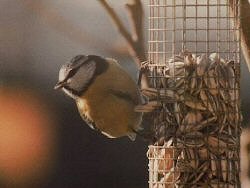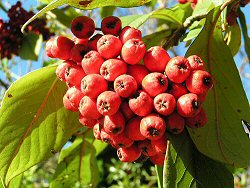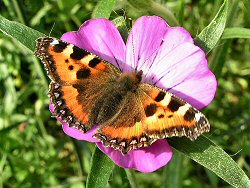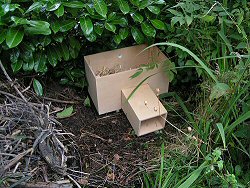| Features: Wildlife Trust Articles |  |
Winter Drama in the Wildlife Garden Blue tit (Parus caeruleus) on a sunflower seed feeder in winter.
For the animals that inhabit our gardens, winter brings some of the greatest survival challenges of their lives and what we do as gardeners will have a big impact on their chances of seeing another summer. Blue tit (Parus caeruleus) on a sunflower seed feeder in winter.
For the animals that inhabit our gardens, winter brings some of the greatest survival challenges of their lives and what we do as gardeners will have a big impact on their chances of seeing another summer.
Animals living in higher latitudes, like ours, have evolved different types of behaviour to deal with the colder months. There are three basic strategies:
- migrate to get away from the cold weather;
- stay put and remain active;
- stay put and hibernate.
We can find animals which fit into all of these groups in our own gardens. By understanding more about the way each type of animal deals with the winter weather, we can do our bit to make our gardens places where their chances of survival are maximised.
Migrants
Most conspicuous of the animals which adopt this strategy are those best equipped to carry it off: the birds. When we think of bird migration, those which normally spring to mind are swallows (Hirundo rustica), house martins (Delichon urbica), fly catchers and warblers. These are birds which help make the summer garden a special place in Britain, but they escape our winter weather by flying to places like Africa or southern Europe. However,  there are also birds that migrate into our gardens during the course of the winter; escaping from even harsher weather in places like Scandinavia and Iceland there are also birds that migrate into our gardens during the course of the winter; escaping from even harsher weather in places like Scandinavia and Iceland there are also birds that migrate into our gardens during the course of the winter; escaping from even harsher weather in places like Scandinavia and Iceland. there are also birds that migrate into our gardens during the course of the winter; escaping from even harsher weather in places like Scandinavia and Iceland.
 Berries of cotoneaster - a great favourite of many winter visitors.
Winter migrants like redwings (Turdus iliacus), fieldfares (Turdus pilaris), bramblings (Fringilla montifringilla)and waxwings (Bombycilla garrulus) turn an average winter's day into red-letter day when they show up in the garden. Berries of cotoneaster - a great favourite of many winter visitors.
Winter migrants like redwings (Turdus iliacus), fieldfares (Turdus pilaris), bramblings (Fringilla montifringilla)and waxwings (Bombycilla garrulus) turn an average winter's day into red-letter day when they show up in the garden.
Many winter migrants are attracted to our gardens to feed from berry-bearing shrubs. By including fruiting trees and shrubs like hawthorn (Crataegus monogyna), holly (Ilex aquifolium), firethorn (Pyracantha coccinea) and cotoneaster (Cotoneaster spp.) in your garden, you can maximise your chances of seeing these special visitors and do your bit to help them survive the winter. Shrubs like these will also provide welcome shelter and roosting places for hard-pressed winter visitors.  Many birds, whether winter migrants or residents of the wider countryside, will move into gardens when the winter weather is at is very worst Many birds, whether winter migrants or residents of the wider countryside, will move into gardens when the winter weather is at is very worst Many birds, whether winter migrants or residents of the wider countryside, will move into gardens when the winter weather is at is very worst - freezing fields and their natural food and water sources. By providing a variety of natural and supplementary foodstuffs as well as un-frozen water during these periods, your garden really can make the difference between life and death. Many birds, whether winter migrants or residents of the wider countryside, will move into gardens when the winter weather is at is very worst - freezing fields and their natural food and water sources. By providing a variety of natural and supplementary foodstuffs as well as un-frozen water during these periods, your garden really can make the difference between life and death.
Active residents Female blackbird (Turdus merula) with berries of firethorn. Female blackbird (Turdus merula) with berries of firethorn.
Many of our birds and most of our mammals adopt a strategy of remaining for the winter and staying active. Those which feed on seeds and/or fruit can normally find enough to eat during the winter, but much depends on the success, or otherwise, of the natural crops which comprise their food.  Gardeners can do a lot of important work to help animals like these survive the winter by providing supplementary winter food like seeds, fat and a variety of other scraps Gardeners can do a lot of important work to help animals like these survive the winter by providing supplementary winter food like seeds, fat and a variety of other scraps Gardeners can do a lot of important work to help animals like these survive the winter by providing supplementary winter food like seeds, fat and a variety of other scraps. Some species are more likely to come into gardens in winters when their natural food is in shorter supply; for example more great tits spend the winter in gardens in years when the natural crop of beech mast has been poor. Gardeners can do a lot of important work to help animals like these survive the winter by providing supplementary winter food like seeds, fat and a variety of other scraps. Some species are more likely to come into gardens in winters when their natural food is in shorter supply; for example more great tits spend the winter in gardens in years when the natural crop of beech mast has been poor.
If you provide a ground feeding station (like a bird table, but just a few inches off the ground), not only will you help those birds that are not keen to use other feeders (e.g. song thrushes (Turdus philomelos) and dunnocks (Prunella modularis)), but you can also do a great service for your garden's small mammal population. Animals like field voles (Microtus agrestis), bank voles (Clethrionomys glareolus) and the charming wood-mouse (Apodemus sylvaticus) will all visit ground feeders to supplement their natural vegetarian diets. They are most active at night but in winter, when they have to eat especially well to survive, you may also see them during the day.  Small mammals will prefer feeding stations to be close to cover, but you may want to cover the whole structure with a metal wire frame if cats or rats are likely to be a nuisance in your garden Small mammals will prefer feeding stations to be close to cover, but you may want to cover the whole structure with a metal wire frame if cats or rats are likely to be a nuisance in your garden Small mammals will prefer feeding stations to be close to cover, but you may want to cover the whole structure with a metal wire frame if cats or rats are likely to be a nuisance in your garden. Small mammals will prefer feeding stations to be close to cover, but you may want to cover the whole structure with a metal wire frame if cats or rats are likely to be a nuisance in your garden.
Other mammals like shrews and birds such as wrens (Troglodytes troglodytes) are largely carnivorous and must find live prey throughout the winter; but invertebrates at this time of year, as we shall see, are hard to find. To add to their problems, these small predators must eat surprisingly large numbers of invertebrates because they lose so much body heat in the winter. We can help them by putting out live food like mealworms (larvae of Tenebrio molitor) and waxworms (larvae of Galleria mellonella) which are nowadays readily available from suppliers who will deliver them to your door.
 Gardeners can grow climbers like ivy (Hedera helix) and dense evergreen shrubs like holly and yew (Taxus baccata) will which will all provide shelter and roosting places for small birds and mammals Gardeners can grow climbers like ivy (Hedera helix) and dense evergreen shrubs like holly and yew (Taxus baccata) will which will all provide shelter and roosting places for small birds and mammals Gardeners can grow climbers like ivy (Hedera helix) and dense evergreen shrubs like holly and yew (Taxus baccata) will which will all provide shelter and roosting places for small birds and mammals. Habitat piles made of logs and rocks, especially where overgrown with vegetation, will also provide them with safe havens. If you clean out bird nesting boxes in autumn to remove any old nesting material (which can harbour parasites and disease) and add a little clean dry straw, the boxes are likely to be used as roosting sites by birds in winter. Over 40 wrens have been counted emerging from a single nest box during the winter! Gardeners can grow climbers like ivy (Hedera helix) and dense evergreen shrubs like holly and yew (Taxus baccata) will which will all provide shelter and roosting places for small birds and mammals. Habitat piles made of logs and rocks, especially where overgrown with vegetation, will also provide them with safe havens. If you clean out bird nesting boxes in autumn to remove any old nesting material (which can harbour parasites and disease) and add a little clean dry straw, the boxes are likely to be used as roosting sites by birds in winter. Over 40 wrens have been counted emerging from a single nest box during the winter!
Hibernators The tortoiseshell butterfly hibernates as an adult and is often found by householders
Have you ever wondered what happens in winter to all of the invertebrates that bring our summer gardens to life? The tortoiseshell butterfly hibernates as an adult and is often found by householders
Have you ever wondered what happens in winter to all of the invertebrates that bring our summer gardens to life?  Most insects have annual life cycles that enable the next generation to see out the winter as an early development stage Most insects have annual life cycles that enable the next generation to see out the winter as an early development stage Most insects have annual life cycles that enable the next generation to see out the winter as an early development stage (e.g. egg, lava or pupa). There are examples of butterflies which over-winter in each of the main life stages; egg, larva (caterpillar), pupa (chrysalis) and adult (butterfly). Most gardeners have, at one time or another, come across a hibernating tortoiseshell (Aglais urticae) butterfly in an outhouse or garage. Occasionally they start their hibernation within the house itself only to be rudely awakened when the central heating kicks in during the autumn. Most insects have annual life cycles that enable the next generation to see out the winter as an early development stage (e.g. egg, lava or pupa). There are examples of butterflies which over-winter in each of the main life stages; egg, larva (caterpillar), pupa (chrysalis) and adult (butterfly). Most gardeners have, at one time or another, come across a hibernating tortoiseshell (Aglais urticae) butterfly in an outhouse or garage. Occasionally they start their hibernation within the house itself only to be rudely awakened when the central heating kicks in during the autumn.  If you find a butterfly that has been prematurely awakened like this, don't put it into the cold garden, but release it into a cool, but sheltered place such as a garage or shed If you find a butterfly that has been prematurely awakened like this, don't put it into the cold garden, but release it into a cool, but sheltered place such as a garage or shed If you find a butterfly that has been prematurely awakened like this, don't put it into the cold garden, but release it into a cool, but sheltered place such as a garage or shed. If you find a butterfly that has been prematurely awakened like this, don't put it into the cold garden, but release it into a cool, but sheltered place such as a garage or shed.
Whatever their life stage, insects enter a period of arrested development called diapause in the winter which is akin to hibernation in mammals. They often produce a kind of natural anti-freeze which prevents the severe cold from damaging their tissues. So  although we usually can't see many insects in the winter garden, rest assured they are all around: in the leaf litter, in the soil, behind bark, in hollow plant stems, under stones although we usually can't see many insects in the winter garden, rest assured they are all around: in the leaf litter, in the soil, behind bark, in hollow plant stems, under stones although we usually can't see many insects in the winter garden, rest assured they are all around: in the leaf litter, in the soil, behind bark, in hollow plant stems, under stones - in fact in just about any nook or cranny that you care to name. You can help over-wintering invertebrates in the garden by supplying more of the nooks and crannies e.g. by providing habitat piles or even putting out some of the commercially available bug boxes. But although we usually can't see many insects in the winter garden, rest assured they are all around: in the leaf litter, in the soil, behind bark, in hollow plant stems, under stones - in fact in just about any nook or cranny that you care to name. You can help over-wintering invertebrates in the garden by supplying more of the nooks and crannies e.g. by providing habitat piles or even putting out some of the commercially available bug boxes. But  perhaps the single most important thing you can do is to delay the traditional autumn tidy up until spring. The plant and the leaf litter provide myriad places for invertebrates to over-winter perhaps the single most important thing you can do is to delay the traditional autumn tidy up until spring. The plant and the leaf litter provide myriad places for invertebrates to over-winter perhaps the single most important thing you can do is to delay the traditional autumn tidy up until spring. The plant and the leaf litter provide myriad places for invertebrates to over-winter; if you leave the tidy up until spring when these animals have continued their development, you will give a huge boost to your garden's ecology. Remember, perhaps the single most important thing you can do is to delay the traditional autumn tidy up until spring. The plant and the leaf litter provide myriad places for invertebrates to over-winter; if you leave the tidy up until spring when these animals have continued their development, you will give a huge boost to your garden's ecology. Remember,  invertebrates not only make an important contribution to our enjoyment of the garden in their own right, but they are an absolutely crucial element of the garden food-webs which sustains birds, mammals, amphibians and all invertebrates not only make an important contribution to our enjoyment of the garden in their own right, but they are an absolutely crucial element of the garden food-webs which sustains birds, mammals, amphibians and all invertebrates not only make an important contribution to our enjoyment of the garden in their own right, but they are an absolutely crucial element of the garden food-webs which sustains birds, mammals, amphibians and all. invertebrates not only make an important contribution to our enjoyment of the garden in their own right, but they are an absolutely crucial element of the garden food-webs which sustains birds, mammals, amphibians and all.
 Hedgehog: one of our most familiar garden mammals
Of our mammals only the bats, dormouse (Muscardinus avellanarius) and (perhaps most famously) the hedgehog (Erinaceus europaeus) hibernate during the winter. When warm-blooded mammals hibernate, they undergo some dramatic physiological changes which enable them to survive long periods without expending much energy and therefore making fewer demands on their stored fat reserves. When a hedgehog hibernates, its pulse rate drops from around 190 beats per minute to about 20; it takes only one breadth every minute or two; and its temperature drops from 35 to 10 degrees centigrade, although the core body temperature remains higher. Although they may rouse slightly during periods of warmer weather, our hibernating mammals will not normally wake up properly and move unless they are disturbed. Hedgehog: one of our most familiar garden mammals
Of our mammals only the bats, dormouse (Muscardinus avellanarius) and (perhaps most famously) the hedgehog (Erinaceus europaeus) hibernate during the winter. When warm-blooded mammals hibernate, they undergo some dramatic physiological changes which enable them to survive long periods without expending much energy and therefore making fewer demands on their stored fat reserves. When a hedgehog hibernates, its pulse rate drops from around 190 beats per minute to about 20; it takes only one breadth every minute or two; and its temperature drops from 35 to 10 degrees centigrade, although the core body temperature remains higher. Although they may rouse slightly during periods of warmer weather, our hibernating mammals will not normally wake up properly and move unless they are disturbed.  A hedgehog will wake if its body temperature drops to a dangerous level indicating that its hibernating place (hibernacula) is not up to scratch A hedgehog will wake if its body temperature drops to a dangerous level indicating that its hibernating place (hibernacula) is not up to scratch A hedgehog will wake if its body temperature drops to a dangerous level indicating that its hibernating place (hibernacula) is not up to scratch. At such times it will shiver to raise its body temperature and go and seek out a new place to hibernate. Needless to say, disturbances like these place severe demands on the animals already depleted fat reserves and lessen its chances of surviving the winter. A hedgehog will wake if its body temperature drops to a dangerous level indicating that its hibernating place (hibernacula) is not up to scratch. At such times it will shiver to raise its body temperature and go and seek out a new place to hibernate. Needless to say, disturbances like these place severe demands on the animals already depleted fat reserves and lessen its chances of surviving the winter.
Amphibians like frogs (Rana temporaria), toads (Bufo bufo) and newts (Triturus spp.) also enter a kind of hibernation during the winter, but being cold blooded, the physiological changes they undergo are different from those of mammals. Amphibians tend to seek out a place in which to spend the winter that will be frost-free, since it is the frost that can damage body tissues. There they let their body temperatures drop with their surroundings so that they enter a state of extreme torpor.  Male frogs often spend the winter in the mud at the very bottom of ponds whilst the females (and other males) prefer to hibernate away from the pond, as do toads and newts Male frogs often spend the winter in the mud at the very bottom of ponds whilst the females (and other males) prefer to hibernate away from the pond, as do toads and newts Male frogs often spend the winter in the mud at the very bottom of ponds whilst the females (and other males) prefer to hibernate away from the pond, as do toads and newts. These animals see out crevices underneath rocks and stones, in log piles and deep within leaf and plant litter as well as the soil itself. Male frogs often spend the winter in the mud at the very bottom of ponds whilst the females (and other males) prefer to hibernate away from the pond, as do toads and newts. These animals see out crevices underneath rocks and stones, in log piles and deep within leaf and plant litter as well as the soil itself.
 A hibernation/nesting box for a hedgehog (here with the lid off) A hibernation/nesting box for a hedgehog (here with the lid off)  Gardeners can help hibernating animals by keeping disturbance of possible hibernating places to a minimum Gardeners can help hibernating animals by keeping disturbance of possible hibernating places to a minimum Gardeners can help hibernating animals by keeping disturbance of possible hibernating places to a minimum. Never turn or otherwise disturb a compost heap in winter since they are popular hibernating places for both amphibians and mammals. The same is true of habitat piles made from logs or stones. We can make or buy bat boxes which may be used in winter and hedgehog boxes which can be used both for breeding and hibernating. It is very easy to improvise good hibernating spots for hedgehogs, for example by leaning a sheet of plywood against a fence, wall or hedge in a quite spot and covering it with leaves and branches: the space underneath the board can become a snug spot for an over-wintering hedgehog. Gardeners can help hibernating animals by keeping disturbance of possible hibernating places to a minimum. Never turn or otherwise disturb a compost heap in winter since they are popular hibernating places for both amphibians and mammals. The same is true of habitat piles made from logs or stones. We can make or buy bat boxes which may be used in winter and hedgehog boxes which can be used both for breeding and hibernating. It is very easy to improvise good hibernating spots for hedgehogs, for example by leaning a sheet of plywood against a fence, wall or hedge in a quite spot and covering it with leaves and branches: the space underneath the board can become a snug spot for an over-wintering hedgehog.
In winter we need to look at our gardens through different eyes and turn our thoughts as much to the things that we don't see as those that we do. By understanding more about how our garden animals are coping with one of the most testing periods in their lives, we will be in a better position to help them come through it.
| First published December 2004. | |
Copyright Richard Burkmar. Permission is hereby granted for anyone to use this article for non-commercial purposes which are of benefit to the natural environment as long the original author is credited. School pupils, students, teachers and educators are invited to use the article freely. Use for commercial purposes is prohibited unless permission is obtained from the copyright holder. |
Back to home page
Do you live in Merseyside? Interested in its wildlife? | |